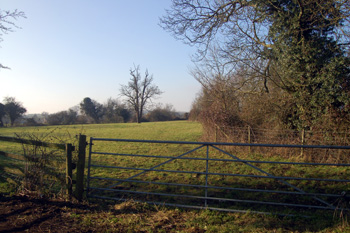Salford Vicarage
![The site of the Vicarage here outlined in green on a map of 1596 [X74/2]](/CommunityHistories/Salford/SalfordImages/The site of the Vicarage here outlined in green on.jpg)
The site of the Vicarage here outlined in green on a map of 1596 [X74/2]
The Bedfordshire Historic Environment Record [HER] contains information on the county's historic buildings and landscapes and summaries of each entry can now be found online as part of the Heritage Gateway website. The entry for Salford Vicarage [HER 1194] states: "An earthwork, which appears on aerial photographs, corresponds with an enclosure called Vicars Close on a map of 1596; later maps give names such as Vicarage Meadows for the surrounding fields. The evidence suggests that this was the site of a vicarage.
The first description of the Vicarage comes in an archdeaconry wide terrier of church property of 1607 [ABE1]. It is described as being built of timber and having four bays (two chambered and boarded) – a half-timbered house with two bedchambers upstairs. The roof was partly tiled and partly thatched and there were seven rooms in all. A barn of eight bays stood outside. A terrier of 1690 [ABE1] gives a description of a four bay building and a barn of three bays with a stable, hayhouse and lean-to structure.
A terrier of 1707 [ABEII volume II page 550] describes a four bay building with a partly tiled roof and a room downstairs with a brick floor "all bays lofted". The barn was of three bays, boarded and thatched and there was a still stable with a hay barn and lean-to. Finally, a terrier two years later [ABEII Volume I page 334] has a timber and thatched building with four small rooms with earthen floors and two chambers, one boarded and one with a clay floor.
In 1750 the parishes of Hulcote and Salford were brought into union as one parish. From that time Salford Vicarage was no longer used as a parsonage but was used, instead, as a dwelling for poor people. In 1824 Edward Orlebar Smith, Rector since 1790, applied for a faculty to demolish the old vicarage [P77/2/2].
In the preamble it stated that he had entirely rebuilt , where the Rector for the combined parish lived, and had applied to pull down the vicarage but had been denied because there was still eight years of a lease to run. The rector then spent time and money ejecting the tenant who had not maintained the place so that it had become ruinous. The rector had wished to use some of the fabric from the vicarage to rebuild the rectory but was thus forced to spend his own money on all the necessary materials. As the vicarage was now a ruin permission was given and Salford Vicarage was, presumably, swiftly pulled down.
 Vicarage Close January 2011
Vicarage Close January 2011